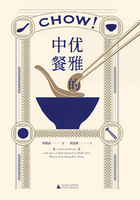
THE ART OF COOKING
China is a country where the appreciation of good food is developed into a fine art. Chinese are epicures. Their cooking is distinctive: No other cooking resembles it in any way.
Chinese food is rich, but not greasy; it is delicately flavoured, but not pungently spicy. Cook what is freshly slaughtered, and eat what is freshly cooked(现杀、现烹、现熟、现食)is a doctrine universally recognised throughout China. It is better that one should wait for the meal than that the meal should wait for one. Variety is another important feature. A Chinese dish almost always consists of a mixture of foodstuffs—the meat or fish is generally cooked with, and improved by, the addition of some appropriate vegetable. All the material to be used is cut into convenient size in the kitchen before serving, so that no carving instruments are required at the table. All the condiments are added during the process of cooking, thus doing away with the necessity of the usual cruet. The only exceptions are some soya bean sauce and vinegar provided at the table in case they are required.
With the passage of time the methods of cooking have necessarily undergone many improvements as compared with the original crude processes. Expert cooks in different parts of China have introduced numerous improvements, and, with China being such a vast country, its component parts differing widely not only in climate and customs, but even in the spoken language, it is only to be expected that different terms are found in different localities for the same way of cooking. For instance, roasting in the North is known as K'ao(烤)while in the South it is called Shao(烧). Similarly Shao Fan(烧饭)in North China means cooking rice, but in Canton they say Chu Fan(煮饭).In these circumstances I have to employ those terms which are more commonly used and are more generally understood. All the terms used in this little book are in the National language, that is, Mandarin [Kuo Yü(国语)].